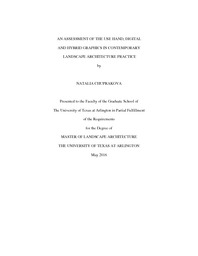| dc.description.abstract | Visual representation is a critical component of professional landscape architecture practice. The tools that are used for visual representation production are hand, digital and hybrid graphics. This thesis evaluates the existing representational tools available in professional practice within United States. It takes into consideration factors such as professional position, years of accrued experience in the profession, level of professional degree and type of landscape architecture practice and shows how the various factors noted above influence choices made regarding graphics type preference. Furthermore, this study evaluates the role that given graphics types play in the design process, as well as current trends and tendencies in graphics use within contemporary landscape architecture. Based on these questions, a national online survey was conducted and sent to randomly selected full and associate members of the American Society of Landscape Architects (ASLA). More than 400 individuals responded, with an overall response rate of 17%.
The data obtained from the survey suggest that use of hand graphics relates to the professional experience and position of respondents. Their use of digital graphics relates to their years of experience and specific types of practice, and respondents’ use of hybrid graphics correlates with the type of practice. The data also show that different graphics types are best suited to have different stages of the design process. Thus, hand graphics are used primarily during the inventorial and conceptual stages; digital graphics are preferable in the design development and final stages, and hybrid graphics are used with equal frequency for all stages of the design process. The data also indicates that certain tasks are employed to produce each of the three graphics types. An additional finding shows that different graphics types are selected based on the type of communication participants with whom landscape architecture professionals interact. | |

